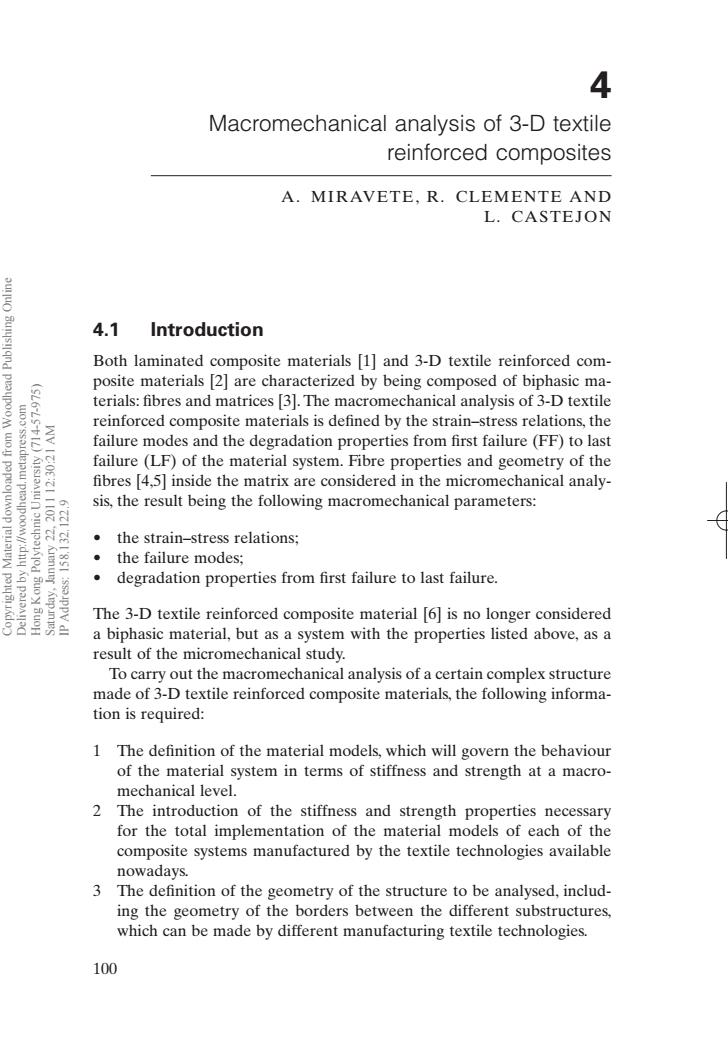正在加载图片...

4 Macromechanical analysis of 3-D textile reinforced composites A.MIRAVETE,R.CLEMENTE AND L.CASTEJON 4.1 Introduction Both laminated composite materials [1]and 3-D textile reinforced com- posite materials [2]are characterized by being composed of biphasic ma- terials:fibres and matrices [3].The macromechanical analysis of 3-D textile reinforced composite materials is defined by the strain-stress relations,the 2 WV IZOE failure modes and the degradation properties from first failure(FF)to last failure (LF)of the material system.Fibre properties and geometry of the fibres [4,5]inside the matrix are considered in the micromechanical analy- 5 sis,the result being the following macromechanical parameters: pua aic the strain-stress relations; 。the failure modes; 、 degradation properties from first failure to last failure 豆 The 3-D textile reinforced composite material [6]is no longer considered a biphasic material,but as a system with the properties listed above,as a result of the micromechanical study. To carry out the macromechanical analysis of a certain complex structure made of 3-D textile reinforced composite materials,the following informa- tion is required: 1 The definition of the material models,which will govern the behaviour of the material system in terms of stiffness and strength at a macro- mechanical level. 2 The introduction of the stiffness and strength properties necessary for the total implementation of the material models of each of the composite systems manufactured by the textile technologies available nowadays. 3 The definition of the geometry of the structure to be analysed,includ- ing the geometry of the borders between the different substructures, which can be made by different manufacturing textile technologies. 1004.1 Introduction Both laminated composite materials [1] and 3-D textile reinforced composite materials [2] are characterized by being composed of biphasic materials: fibres and matrices [3]. The macromechanical analysis of 3-D textile reinforced composite materials is defined by the strain–stress relations, the failure modes and the degradation properties from first failure (FF) to last failure (LF) of the material system. Fibre properties and geometry of the fibres [4,5] inside the matrix are considered in the micromechanical analysis, the result being the following macromechanical parameters: • the strain–stress relations; • the failure modes; • degradation properties from first failure to last failure. The 3-D textile reinforced composite material [6] is no longer considered a biphasic material, but as a system with the properties listed above, as a result of the micromechanical study. To carry out the macromechanical analysis of a certain complex structure made of 3-D textile reinforced composite materials, the following information is required: 1 The definition of the material models, which will govern the behaviour of the material system in terms of stiffness and strength at a macromechanical level. 2 The introduction of the stiffness and strength properties necessary for the total implementation of the material models of each of the composite systems manufactured by the textile technologies available nowadays. 3 The definition of the geometry of the structure to be analysed, including the geometry of the borders between the different substructures, which can be made by different manufacturing textile technologies. 4 Macromechanical analysis of 3-D textile reinforced composites A. MIRAVETE, R. CLEMENTE AND L. CASTEJON 100 RIC4 7/10/99 7:43 PM Page 100 Copyrighted Material downloaded from Woodhead Publishing Online Delivered by http://woodhead.metapress.com Hong Kong Polytechnic University (714-57-975) Saturday, January 22, 2011 12:30:21 AM IP Address: 158.132.122.9